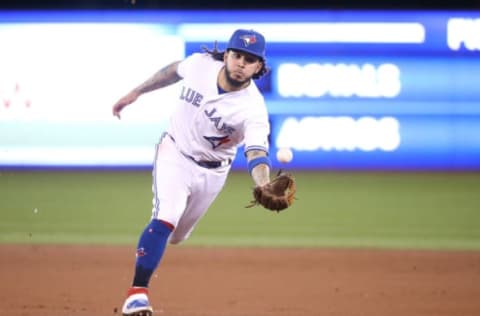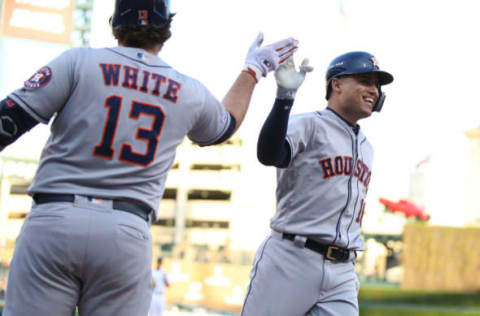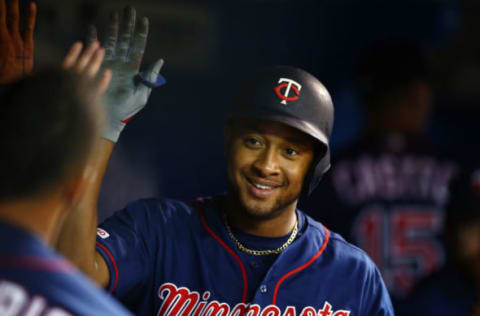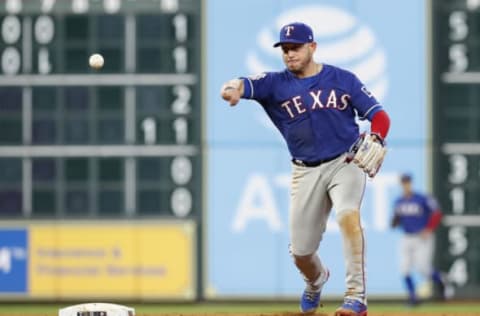Blue Jays: What kind of return could they get for Freddy Galvis?


The assumption is that the Blue Jays will trade veterans later in the year, which could include Freddy Galvis. What kind of trade return could we expect for the talented shortstop?
It may be quite some time before the Blue Jays decide what they’re doing with starting pitchers like Marcus Stroman and Aaron Sanchez, but my guess is they’ll be active sellers prior to the July 31st trade deadline whether they deal that duo or not.
That’s because the Blue Jays should have several useful veterans that could interest possible contenders as the season wears on. A lot of that trade market will be determined by need, and we may not know that until later in the season, but guys like Justin Smoak, Clay Buchholz, Clayton Richard, and Freddy Galvis should be on the block for sure, if not several others.
That last name could be the most interesting one to work with for Ross Atkins and the front office. An established big league shortstop has value, and even though Galvis is on a one year deal (with a club option), he could help shore up a lot of infields around the league and I’m sure there are several GM’s that will be keeping an eye on his production as the summer gets closer.
I don’t know that we’ll ever get a perfect comparison for Galvis on the trade market, or as I said, that the variables will line up the same way for the interested parties. However, let’s have a look at what some of the recently traded shortstops have brought back in trade, and what kind of expectations the Blue Jays could have this summer

Houston Astros acquire Diaz from the Blue Jays
Why not start with an example that most Blue Jay fans will remember well? Last season the most frequent starter at shortstop in Toronto was Aledmys Diaz, who had been acquired the winter before from the Cardinals. He was seen as an insurance policy in case Troy Tulowitzki couldn’t get healthy, and it turned out to be a great decision by Ross Atkins and the front office.
Diaz not only provided the Blue Jays with a solution for the 2018 season, but he also brought back a pretty nifty trade return for Atkins at the start of a rebuild. The Blue Jays managed to flip him to Houston for Trent Thornton, a quality starting pitcher who would have been left unprotected by the Astros in the Rule 5 draft, so they had to do something and the Blue Jays pounced.
Let me be clear, Diaz is not as good as Galvis on either side of the ball, but having four full years of contract control gives him some extra value. He’ll earn two million this season and then enter the first of three years of arbitration eligibility. The Blue Jays also took advantage of the fact that the Astros had to make a move with Thornton, and in theory, the trade works out for both parties. However, it should tip in the Blue Jays’ favour, if it hasn’t already.
What can we learn from the Blue Jays getting Thornton for Diaz? Hopefully Galvis is worth at least one big league calibre starting pitcher. Thornton looks to have an awful lot of upside, so the Blue Jays could certainly do worse if that’s the type of return they get when they put Galvis on the market.

Arizona gets Escobar in a four-player swap
One of the stronger comparisons I can find for an infielder traded over the year or so is Eduardo Escobar, who was dealt to Arizona from the Minnesota Twins in a four-player trade last year.
Escobar was worth 3.2 bWAR combined last season between the Twins and Diamonbacks, and that earned him a new three year deal in Arizona. The 30 year is just a little bit older than Galvis, and has had a great start to the 2019 season so far. He’s capable of playing around the infield and has spent the majority of his time at third base with the D-backs.
In return for Escobar, the Twins did quite well by getting minor league RHP Jhoan Duran and outfielders Ernie De La Trinidad and outfielder Gabriel Maciel from Minnesota. Duran is now ranked as the #7 prospect in the Twins system according to MLB pipeline, and would definitely be the centre-piece of the deal.
Neither Maciel or De LA Trinidad figure to be sure-fire big league ballplayers, but each should have a chance to make a career at the highest level, with the former being viewed as a top 20 prospect in the Twins’ system, and ranking at #25 according to the Pipeline.
Once again the main piece of the trade was a solid starting pitching prospect, and in this case Escobar was able to bring back a couple of wild card outfield options too. If Maciel can develop into more, they may win the trade some day even if Escobar can keep up the current production he’s displayed in the National League.

Brewers acquire Schoop from Baltimore
One of the deadline deals that didn’t work out for the contending team would be when the Brewers brought in Jonathan Schoop from Baltimore.
It was an imperfect fit from the get-go, much like comparison Schoop to Galvis, but stay with me for a minute anyway. Admittedly, Schoop’s situation is different because a) he’s primarily a second baseman, b) he has a higher offensive ceiling, and c) he had an option year on his contract for 2019 (that the Brewers declined).
The former All-Star was having a bit of a down year when he was dealt, but the reason the Brewers were interested was because Schoop had the potential to be a big upgrade, especially on offence. He’s hit more than 20 home runs in three different seasons, including his career high of 32 in 2017, so that’s the player the Brewers were hoping they were getting, even if he had to play out of position at shortstop to make it work.
The return for the Orioles was an interesting one because they took back a well-known young player in Jonathan Villar, who badly needed a fresh start somewhere else. He’s been better in Baltimore this year, and still has the potential to find himself again at 28 years old. Baltimore also received a minor league pitcher by the name of Luis Ortiz, and a shorstop named Jean Carmona.
The Orioles aren’t known for having a strong minor league system, but Ortiz is now ranked at #18 among their prospects, and Carmona comes in at #23. Considering how poorly the trade worked out for Milwaukee, that’s a pretty good return for the Orioles, and one the Blue Jays could try to use as a model.

The Low End Of A Potential Return
Call these worst-case scenario examples if you will, but we may as well look at the low-end possibilities as well if the market doesn’t play in the Blue Jays’ favour this summer.
One infielder who was dealt last year in a pretty minor trade was Asdrubal Cabrera, a veteran known more for his bat than his glove. He was dealt from the Mets to the Phillies last year and New York received a minor league pitcher named Franklyn Kilome in return. The Mets don’t have a terribly strong system either, but Kilome is now ranked at #9 among their prospects.
More from Jays Journal
- Matt Chapman has been exactly what the Blue Jays needed
- Blue Jays: The goalposts are moving in the right direction
- Single-A Dunedin Blue Jays advance to the Championship Series
- Blue Jays: Comparisons for Alek Manoah’s Second Season
- Blue Jays: Adam Cimber, the unlikely decision King
Last but not least from last year’s deadline, we could include Ian Kinsler as well, although Galvis should be worth far more than him at this stage of their respective careers. Galvis has the far superior glove and likely is a much better hitter these days as well.
For the sake of comparison, Kinsler was traded from the Angels to the Red Sox and managed to get himself a World Series ring in the prospect. In return for the second baseman, the Sox sent left-handed pitcher Williams Jerez to L.A. The 26-year-old southpaw pitched 15 innings in 17 appearances for the Angels last year., and is now in the San Francisco Giants organization, making one appearance in 2019 so far.
Galvis’ solid start to the 2019 season is certainly helping his value and making it easier for Atkins to draw interest before the singular deadline this summer. With so many talented infielders in the minor league system in Toronto, it feels like a foregone conclusion that he’ll get traded this summer, even if his club option for 5.5 million next year could prove to be a bargain as well.
At the time of his signing, I wasn’t sure I was a big fan of the front office bringing in the veteran infielder, but so far he’s worked out to be an important piece of the team and a valued example to the even younger players around him. If they shop him as expected this summer, the infielders that have been traded over the last year paint a fairly positive opportunity for a decent return.
dark. Next. When do the Jays decide if they're dealing?
He’s not going to bring back a top five prospect, but if the Blue Jays can get a top 10-20 piece from a contender, and hopefully another starter with upside, it will make the Galvis signing look even better than it already does.